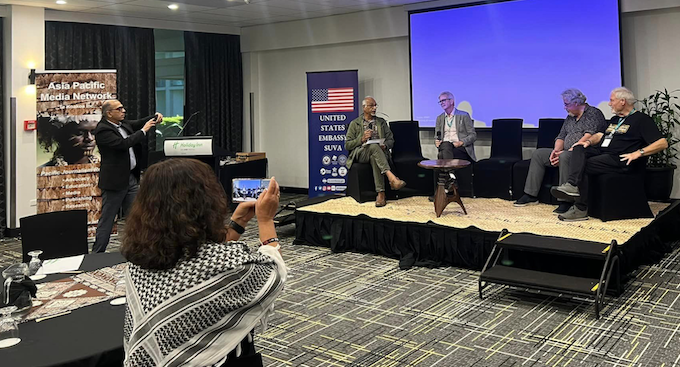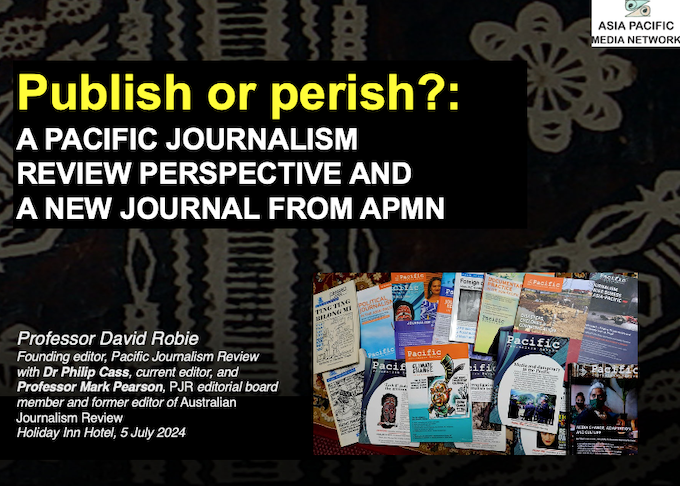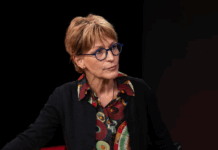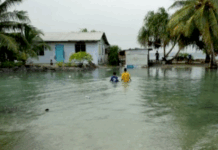
Pacific media academics have criticised the economics of global research journal publication models and defended independent publications such as Pacific Journalism Review carving out niche markets.
Speaking in a panel titled “Publish or Perish” at the recent Pacific International Media 2024 conference in Suva, Fiji, the academics warned that changes in the international research publishing arena were not necessarily an improvement.
In fact, in some cases the changes threatened independent journals and opened the door to “paper mills, AI and sham publications”.
The panel was moderated by adjunct professor in governance Vijay Naidu of The University of the South Pacific and featured a former editor of the Australian Journalism Review, Professor Mark Pearson of Griffith University; founding Pacific Journalism Review editor professor David Robie, and current editor and former PNG newspaper editor and journalism educator Dr Philip Cass.
Introducing the speakers, Professor Naidu said the “Publish or Perish” topic was a pivotal panel and he congratulated conference chair Associate Professor Shailendra Singh, a PJR editorial board member, for the success of the three-day event.
“This panel for media scholars focuses on the ‘heart of the matter’ relating to journalism and the media,” Dr Naidu said.
Researching and writing about the media were critical for both scholars and media practitioners as pertinent topics on current and future development of journalism and the media were covered.
Publishing outlets crucial
Outlets for publishing research findings were crucial for media academics.
Professor Pearson spoke about five key points: the impact of rankings; open access and vanity publishing; “paper mills” and sham journals; the demise of small independent journals; and academic versus journalism outputs.

Discussing global journal rankings, Dr Pearson said the limited level of interest in Pacific issues internationally reduced potential for “prestigious journal” acceptance of papers.
“Journalism researchers ought to avoiding having too many eggs in one basket – and to be aware of the impact of rankings and events on your CV. Decide whether to play the game or not?”
Speaking about open access as a game changer in academic publishing, he said that the flipside was that open access had paved the way for a completely new way to earn a profit.
However, it had meant that journals would not necessarily have any financial incentives to ensure appropriate peer review or quality control — “as long as they can make the researchers pay”.
He cited research by Norwegian academic Martin Hagve who argued in Tidsskriftet that most academic publishers produce content paid for by research funds, including salaries and the expenses of researching.
Pacific Journalism Review message to Pacific Media 2024. Video: Talanoa TV
Editors work for ‘symbolic pay’
“My own experience is that most academic editors work for merely symbolic pay and that quality control and fact-checking are done through peer review, which is unpaid voluntary work,” Hagve wrote.
In 2023, the annual number of papers retracted by research journals had topped 10,000 for the first time, said Dr Pearson. Most analysts believed that the figure was only the tip of an iceberg of scientific fraud.
Dr Pearson lamented the demise of many small independent journals and others becoming vulnerable in the face of the global academic publishing model, such as Pacific Journalism Review that celebrated 30 years of publication at this conference.
PJR editor Dr Philip Cass reaffirmed that it was “incredibly important” to have such a journal because of its “unique position covering the region”.
He also argued strongly for the continuation of print journals at a time when many academic publications are retreating to online only editions.
Professor Robie gave an overview of Pacific Journalism Review and how it had evolved through several design and content styles from when it was first published at the University of Papua New Guinea in 1994.
Del Abcede had played a key role in the design in recent years.

Innovative ‘journalism as research’
Dr Robie spoke about the innovative PJR “journalism as research” model resisted by many academic faculties and described how the journal’s Frontline section, pioneered by Professor Wendy Bacon, had set a benchmark for investigative journalism being recognised by the academe.
He also touched briefly on the Asia Pacific Media Network’s new publishing strategy which includes a new title, Pacific Media, publishing on AUT’s Tuwhera indigenous research platform. Although this publication will feature the usual journal attributes, it will focus more on community outcomes.
- Pacific Journalism Review has been featured by Australian National University’s Devpolicy Blog.














































